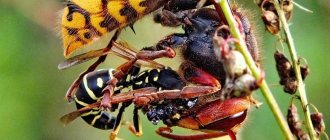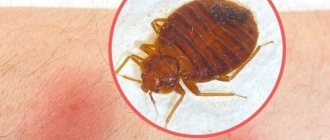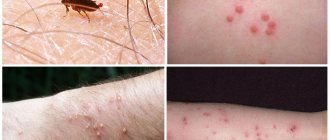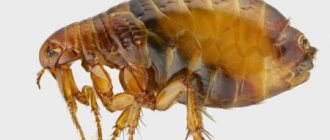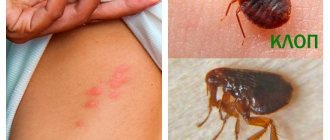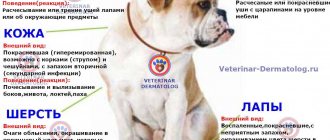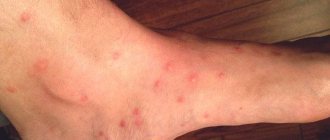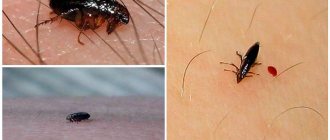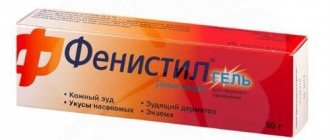As a rule, an allergy to flea bites in humans manifests itself in the form of a skin reaction, and the child’s body reacts more sharply than that of an adult. Flea bites itch and cause redness, dermatitis, or skin rashes. The sooner you can relieve the itching from flea bites, the less likely it is to introduce infections into the wound when scratching. Therefore, if you are bitten by a flea, the first thing you should do is treat the bite site with a soothing lotion or other remedy.
In this article, we will look at the types of allergies to flea bites in humans, symptoms and possible complications.
Flea allergy and its types
There are many varieties of fleas in the world. Most often, a person suffers from allergies to the bites of such types of parasites as:
- Sand flea (also known as earth flea). Mainly found in tropical latitudes - the Caribbean, Australia, India, Africa. The danger of such bites lies in the fact that if males bite through human skin and suck blood, then females penetrate under the upper layer of the epidermis. A flea bite is unpleasant in itself, but in some cases it can cause allergies. In this case, the bitten person experiences severe itching, leakage of fluid (sometimes purulent) from the wound, swelling, and impaired keratinization of skin cells.
- Human flea. The main victim of this insect is humans, but in some cases animals can also suffer from its bites. Unlike most of its relatives, the human flea is relatively large in size: its body length is about 3 mm. In one jump, such a flea can move a distance of up to 0.5 m in length and up to 0.3 m in height.
- Rat fleas. The bites of these insects pose the greatest danger to human health and life. We are not even talking about an allergy to flea bites, although it occurs quite often. The fact is that fleas that parasitize rats can be carriers of serious diseases - typhoid, anthrax, encephalitis, plague. By the way, it was rat fleas that caused the massive plague pandemics (the so-called “Black Death”) that swept Europe in the Middle Ages. Today, allergies to flea bites that parasitize rats are a relatively rare occurrence. It occurs mainly in rural areas, as well as among residents of the ground, basement, first and upper floors (if non-residential premises in houses are infested with rats).
- Cat and dog fleas. Considering that dogs and cats are the most common domestic animals with which people come into close contact, their parasites often “migrate” to their owners. To avoid a possible allergy to flea bites in humans, it is necessary to wear anti-flea collars on pets and from time to time bathe cats and dogs using special shampoos.
How to detect
Another important thing to know about fleas. These parasites are skilled camouflages. It is not always possible to see fleas on a pet. But if you don't see them, it doesn't mean they don't exist! The dog is itching - the first thing the owner should think about is fleas! After all, they come to their sacrifice as if they were going to a canteen. They feed and go into the environment.
But there is one reliable way to detect fleas on an animal. The so-called white paper test. To do this, you need to take a large sheet of white paper or fabric. Give the dog a good comb over him. Then use a damp cotton pad to blot everything that has been poured onto the sheet. If the contents leave brown spots, then this is digested blood in flea feces. A reliable sign of the presence of these parasites on the animal.
It is also a known fact that adults make up only 5% of the problem, and the remaining 95% of fleas in your home are in the form of eggs, larvae and pupae¹. They live mainly indoors where the infected animal lives. Believe me! Carpets, bedding, beds, furniture, and cracks in the floor will be densely populated by flea families. You won't achieve anything in the fight against fleas if you don't influence them too.
Allergy to flea bites: symptoms
In people who have slight sensitivity to fleas, contact with insect saliva does not cause any serious disruption to the functioning of body systems. Usually the bite is accompanied by a sharp stabbing pain, which then turns into itching. Under normal conditions, the burning and swelling of the papules formed during bites goes away within a couple of days.
However, sometimes the immune system reacts abnormally to such a bite. In such cases, there is a high probability of developing a flea allergy. Its symptoms are as follows:
- hyperemia of abscess-like papules with a small red dot-wound in the center;
- formation of blisters, the center of the blister is usually crowned with a vesicle;
- redness of significant areas around the bites;
- severe itching of the skin;
- increased body temperature;
- swollen lymph nodes;
- swelling of the skin (up to the appearance of Quincke's edema).
In some particularly severe cases, an allergy to a flea bite may be accompanied by difficulty breathing, headaches, dizziness, and indigestion. If a bitten person has breathing problems, clouded consciousness and pressure surges, he must be taken to the hospital as soon as possible. These phenomena may be symptoms of anaphylactic shock.
Symptoms
What are the symptoms of this disease? The dog itches, bites, chews itself out, constantly scratching and damaging irritated areas of the body. May jump up suddenly to scratch. Favorite places for fleas to bite are the base of the tail, the back of the back, the groin, and the neck. Itching and lesions in these places can most likely indicate flea allergic dermatitis. If flea allergy symptoms are not treated promptly, it can lead to hair loss, bacterial growth, and serious skin problems. Even just one flea bite on a sensitive animal can cause a serious allergic reaction. On the Internet you can see a huge number of photos of flea dermatitis in dogs. These photographs do not make me smile. Dogs want to be helped as quickly as possible.
Allergy to a flea bite in a child
Flea bites on children are especially dangerous. Due to the fact that children have thinner and more delicate skin, parasites bite children more often and more intensely than adults. In addition, a child's immune system may not always react normally to a bite, which leads to flea allergies.
Causes of food allergies
There are several mechanisms for the development of allergies. But a significant proportion of cases are associated with type 1 hypersensitivity. It is explained by the release of immunoglobulin IgE and the activation of basophils. This reaction occurs in response to the entry into the digestive system of protein compounds recognized by immune cells.
Some predisposing factors are unique to children, others are also found in adults. Among the most common reasons are the following:
- Features of allergens in food. The reaction is most often provoked by antigens with high immunogenicity. They easily overcome the aggressive environment of the stomach. They are found in large quantities in whole milk, fish, eggs, cereals, strawberries, citrus fruits, and nuts.
- Hereditary predisposition. Food allergies are associated with hereditary characteristics of the body. They manifest themselves by increased reactivity, disruptions in the functioning of the immune system, as well as other mechanisms.
- Age-related features of the development of the digestive system. Children have high permeability of the stomach walls, and the acidity of gastric juice is lower than in adults. The composition of the microflora is also different. All this creates favorable conditions for the allergen to come into contact with immune cells.
The condition may be associated with the amount of food eaten and the characteristics of culinary processing. There are cases of so-called cross-allergy to pollen and household dust: some food products with similar compounds in their composition trigger an allergic reaction.
According to many researchers, the formation of allergies is facilitated by dietary violations during pregnancy, as well as early transfer of the child to artificial feeding. Gastrointestinal diseases, especially diseases of the liver, gallbladder, and biliary tract, also trigger and contribute to the exacerbation of allergies.
How to treat allergies to flea bites?
Treatment should be prescribed by a dermatologist or allergist. Depending on the symptoms, he will select the optimal therapy. It usually involves taking oral antihistamines and using topical medications to relieve itching and inflammation. It is very important to refrain from scratching the papules, since violating their integrity can lead to infection.
If at the moment you do not have the opportunity to visit a specialist, you can use the following tips:
- after a bite, wash the skin with water and soap (ideally antibacterial);
- apply ice to the bitten area;
- take an antihistamine;
- consult a doctor.
Treatment
The course of treatment can be divided into two parts: the use of medications when symptoms immediately appear and therapy aimed at prevention. Doctor Luss o (Luss L.V., 2005, p. 140).
Antihistamines are not a panacea, since both with true allergies and with pseudo-allergies, it is important to promptly eliminate risk factors for the development of severe manifestations.
The main ones include concomitant diseases of the gastrointestinal tract, leading to failure of the digestion process, changes in the permeability of the walls of the gastrointestinal tract, and a decrease in the acidity of gastric juice. For this purpose, enzyme preparations, enterosorbents, and probiotics are used.
The most important point after the first measures is to accelerate the elimination of the allergen and prevent further contact with it. The main stages of treatment look like this:
- Symptomatic therapy: taking antihistamines for first aid.
- Elimination of the allergen from the body: prescribing a hypoallergenic diet, pharmacological methods, or a combination of these approaches. If the “provocateur” entered the digestive system recently (several hours ago), enterosorbents will be especially effective. They bind substances in the intestinal lumen, preventing them from further entering the bloodstream. If allergens have been in the body for a long time or a lot of time has passed after a single exposure, elimination occurs naturally, and sorbents will only help in eliminating symptoms.
- Allergen-specific immunotherapy (ASIT). This stage follows only after elimination, comprehensive diagnosis, and accurate identification of the provoking antigen.
ASIT is relevant when irreplaceable dishes are added to the list of those prohibited for consumption; the human body is not provided with everything necessary. This method consists of introducing certain dosages of the allergen, which are gradually increased, which allows the development of immunological tolerance.
Author Luss emphasizes that “the attitude towards ASIT in patients with IPA is not yet clear and contradictory. Basically, preference is given to prescribing elimination diets” (Luss L.V., 2005, p. 140). Perhaps this is due to the need to undergo comprehensive diagnostics and constant long-term treatment when the allergy no longer manifests itself. After all, ASIT can be recommended six months after changing the diet. However, this method is the only option to get everything you need from food when you have allergies.
Nutrition for food allergies
The complex of therapeutic measures necessarily includes a nutritional method. Eliminating the cause—the antigen—is extremely important to improve the condition and prevent exacerbations. A complete avoidance of intolerant foods is expected. For convenience, we have provided a list of permitted and prohibited items in the table:
| Allowed | Prohibited |
| Unfortunate bread | Smoked meats |
| Tea | Vinegar |
| Sugar | Fish |
| Boiled lean beef | Mushrooms |
| Butter and vegetable oils | Bird |
| Fresh cucumbers | Nuts |
| Parsley dill | Whole cow's milk |
| Watermelons | Honey |
| Baked apples | Nuts |
| One-day fermented milk products | Fruits and berries: strawberries, melon, pineapple, citrus fruits |
| Cereals: rice, buckwheat, oatmeal | Vegetables: eggplant, radish, horseradish |
Fasting is strictly prohibited for people with chronic diseases, blood diseases, malignant neoplasms, sore throat, other respiratory diseases, liver and circulatory diseases in history.
You will need to limit or eliminate ready-to-eat cereals, pasta (without eggs), ready-made pies, gingerbread cookies, colored marshmallows, and caramels due to the tartrazine they contain. It is necessary to limit the consumption of wine, beer, fruit juices, gelatin, baking mixes, marinades, and most prepared sauces, as they contain sulfites.
There are different options for therapeutic nutrition:
- Grain-free diet. Involves avoiding cereals, flour products, seasonings, and sauces. Preference is given to meat, vegetables, fruits, and dairy products.
- Egg-free diet. Excludes eggs, seasonings, mayonnaise, sauces and creams, pasta, baked goods containing eggs. The diet consists of meat, dairy products, cereals, vegetables, and fruits.
- Dairy-free diet. Milk, milk porridge, cottage cheese, confectionery, and butter are excluded from the diet. The menu is based on dishes of meat, fish, eggs, cereals, vegetables and fruits.
- Diet excluding milk, cereals, eggs.
Thus, it is not necessary to give up all possible allergens. When you consult a doctor, you will receive accurate recommendations. It is important to make your own assumptions about what exactly could have been the source of unpleasant manifestations.
Keeping a diary will help determine which food allergens could cause a response and which ones are not perceived aggressively by the body. At the same time, you should write down not only everything you eat during the day, but also the cooking methods. Note exactly what manifestations of allergies are observed: skin itching, stool disorders, redness of the skin, nausea.
The main feature of nutrition for allergies is not simply to refuse a certain food, but to find an adequate replacement. The diet must remain balanced, otherwise severe restrictions are likely to lead to vitamin and mineral deficiencies. If you are forced to completely give up milk and eggs, your diet should include a variety of meat and fish dishes. It is better to search for alternatives together with your doctor.
How to speed up the skin healing process?
Since an allergy to a flea bite causes severe itching, it is important to choose the right remedy to combat it. Restoring cream "La-Cri" effectively copes not only with itching and burning of the skin, but also helps eliminate its redness and inflammation. The cream contains natural ingredients: string, walnut and violet extracts, as well as panthenol, bisabolol and avocado oil. They have an antipruritic, antimicrobial, softening and regenerating effect, as a result of which the skin quickly returns to its normal state.
How to get rid of fleas in the house
So how to reliably get rid of fleas in the house? Some topical flea treatments only kill adult fleas, without having any effect on other stages of their development, such as eggs and larvae, for example. This leads to the fact that the flea development cycle continues, fleas come again and again. They bite the dog, injecting their saliva and exacerbating the symptoms of flea allergy. But there are medications that can prevent the problem from spreading, such as Simparica and Stronghold. Simparica causes the death of adult fleas and prevents them from laying eggs, and Stronghold, in addition, also destroys flea larvae.
Clinical researches
Based on the results of numerous clinical studies, La-Cri products, including cream for sensitive skin, are recommended by the St. Petersburg branch of the Union of Pediatricians of Russia.
The effectiveness, safety and tolerability of the products have been proven by a clinical study. The cream is also suitable for daily skin care of children with mild to moderate forms of atopic dermatitis and during remission, accompanied by a decrease in the quality of life of patients. As a result of therapy, a decrease in the activity of the inflammatory process, a decrease in dryness, itching and flaking was noted.
It has been clinically proven that La-Cri cream for sensitive skin:
- reduces itching and irritation;
- relieves skin redness;
- moisturizes and gently cares for the skin.
Sources:
- Kovyazina N.A., Fedosimova N.A., Illek Ya. Yu. Diagnosis of atopic dermatitis in young children, Vyatka Medical Bulletin, 2007
- Smirnova G.I. Managing the course of the disease: atopic dermatitis in children, Russian pediatric journal, 2014
- N.L. Rybkina, Modern approaches to newborn skin care: pediatrician tactics, journal Bulletin of Modern Clinical Medicine, 2014
- I.I. Ryumina, V.V. Zubkov, Newborn skin care, Healthy Child magazine, 2017
First aid for acute allergies
First you need to wash your skin. To do this, use warm water and laundry soap. A protective barrier is created that prevents pathogenic bacteria from entering the wounds. Since parasites carry typhus and brucellosis, you will have to treat the skin with antiseptics (hydrogen peroxide, brilliant green, iodine). The use of drugs in this group will prevent suppuration. You can use medications that stimulate regeneration processes. Sulfur ointment and calamine lotion are best.
If angioedema develops, you should immediately call an ambulance. The patient is calmed down. It is better if he takes a sitting position. Small children should be picked up. The patient is isolated from the source of the allergen. He will have to leave the insect-infested area. Tight clothes are removed from the victim, the buttons on the shirt are undone, the tie is undone, and the chains are removed from the neck. Drinking plenty of mineral water and soda solutions is recommended.
Neutralization of symptoms in adults
It is recommended to select treatment with a doctor. Before using any medicine or traditional medicine, consult an allergist or therapist. The patient must be removed from the flea-infested room. He will be able to return only after thoroughly treating the home with insecticides.
The use of folk remedies
A solution of baking soda helps. To prepare it, you will need to dissolve 1 tsp in 1 glass of warm water. substances. The solution should be used to wipe the wounds at least 3 times a day.
Ice will help get rid of inflammation and swelling. Several cubes are wrapped in gauze or other thin fabric, and then the skin in the affected areas is wiped. After this procedure, the bites itch less.
Soda for inflammation.
Lotions based on green tea, calendula decoction, celandine, dandelion, parsley or plantain help. They should be done 2 times a day: in the morning and before bedtime.
Medicines to stop allergies
To relieve pain and itching, use steroid ointments Hydrocortisone or Flucinar. For other symptoms, antihistamines are prescribed. Most often, Zodak and Tavegil are prescribed from this group of drugs. To relieve itching, use ointments and gels with local action, for example Fenistil. In severe forms of the disease, Advantan, Ketotifen, Suprastin are prescribed. Aggressive medications can only be taken as prescribed by the attending physician.
Sometimes allergies are accompanied by intense pain. In such situations, you will have to take painkillers (for example, Diclofenac).
Introduction
Allergy to the venom of stinging insects (wasps, bees, bumblebees, hornets, ants) is the most common type of insect allergy (IA).
Severe and even fatal reactions to the venom of stinging insects have been known for a long time, but only in 1914 L. Waterhouse suggested, and in 1930 RL Benson and H. Semenov proved that these reactions are based on immunological mechanisms [1 ]. Allergy to the venom of stinging insects occurs among 0.4–8.0% of the population of some foreign countries, and in different regions of our country – from 0.1 to 0.4% [2]. Atopic diseases have been reported in 31–53% of patients allergic to the venom of stinging insects. The largest number of patients sensitized to poison are people under 20 years of age, of which up to 38% are under 12 years of age. The incidence ratio between men and women is 2:1. Local allergic reactions to Hymenoptera venom are observed in 2–19% of the adult population. Systemic reactions, detected in 0.8–5.0% of the population, account for more than 70% of allergic reactions to the venom of stinging insects [3].
The peculiarity of an allergy to the venom of stinging insects is as follows: allergens enter the body parenterally in a natural way, and the rapidity of development and increasing severity of the allergic reaction often leads to death.
Etiology
Stinging insects belong to the order Hymenoptera. Two families are especially important: Vespidae, which includes true wasps (Vespula), long wasps (Dolichovespula), hornets and paper wasps (Polistinae), and Apidae (bee), which includes the honey bee (Apis) and bumblebees (Bombus), and family of ants (Formicidae). An allergy can develop to the venom of one or more types of stinging insects. The venom of Hymenoptera insects contains low molecular weight compounds (biogenic amines, amino acids, phospholipids), basic peptides (melittin, apamin, MSD-peptide - Must Cell Degranulating peptide, kinins, etc.), high molecular weight proteins and enzymes (PLA2, hyaluronidase, etc.) .
Biogenic amines cause dilation and increased vascular permeability and pain. Peptides and phospholipases have toxic effects. Enzymes and high molecular weight peptides can cause allergic reactions [2].
Wasps are the most common cause of allergic reactions to the venom of Hymenoptera insects in Russia. Insects nest in the ground and are easily disturbed during gardening. Wasps concentrate around yard garbage disposals and picnic areas. Hornets, which are similar in origin to wasps, nest in bushes, so special care should be taken when cutting branches. Wasps build nests with honeycombs for several individuals. Nests are located under eaves and beams, in attics and balconies. Bees sting more often in spring and early summer, wasps - in August and September [4].
Pathogenesis
If you are allergic to the venom of stinging insects, the following types of reaction are possible:
- allergic (immunoglobulin E-(IgE)-dependent, IgE-independent);
- toxic;
- pseudo-allergic.
The main mechanism of the majority (95–98%) of allergic reactions to stinging insect venom is type I hypersensitivity, mediated by the production of allergen-specific IgE to insect allergens.
Much less frequently with IA, immunological reactions of types III and IV are observed (according to Gell Coombs). IA to a sting, mediated by a type III immunological reaction, is associated with the production of a mass of IgG class antibodies; Type III immunological reactions are manifested in two clinical forms: systemic – serum sickness, and local – Arthus phenomenon.
Toxic reactions are observed in 7% of cases and develop when stung by numerous insects, the severity of the complications depends on their number. Pain and swelling occur at the sting site. Along with local symptoms, signs of general intoxication develop as a result of hemorrhagic, hemolytic, neurotoxic and histamine-like effects of the poison. The reaction of a healthy person to stings by several dozen insects is characterized by local manifestations in the form of pain, swelling and hyperemia, as well as chills, headache, nausea and vomiting. When stung by 100–200 insects, a toxic reaction of moderate severity develops; when stung by 300–400 individuals at the same time, a severe toxic reaction occurs; stings from more than 500 individuals are usually fatal. Typically toxic reactions subside within an hour. However, with multiple stings, the manifestation of the toxic effect of the poison is longer and is complicated by hemorrhagic syndrome (hemolysis of red blood cells, hemoglobinuria), collapse, damage to the nervous system (delirium, areflexia, hypersalivation, convulsions, paralysis), acute necrosis of skeletal muscles, acute renal failure, leading to death outcome [5].
Pseudoallergic reactions may be a consequence of the primary nonspecific histamine-releasing action of some components of the poison. They are often found among patients with urticaria pigmentosa, also called mastocytosis. The reason is the accumulation in the skin and internal organs of mast cells (mast cells), containing many biologically active substances [3].
Clinic
Allergic reactions to the venom of stinging insects are divided into local and systemic.
The literature presents classifications of immediate type allergic reactions by the following authors: H.L. Muller (1966), Molkhow (1972), A.V. Artamasova (1973), Urbanek (1980), UR Muller (1990). Most often in clinical practice, the UR Muller 1990 classification is used (Table 1) [2].
Local allergic reactions occur among 2–19% of the adult population in Europe and America. Mild local reactions (the most common) are accompanied by pain limited to the sting site, transient erythema and swelling. The reactions usually resolve within a few hours [6].
A large local allergic reaction is swelling at the sting site of more than 10 cm, develops minutes or hours (10–15 hours) after the sting and persists for more than 24 hours. Hyperemia and edema spread quickly and are accompanied by painful itching, persist for 5–6 days and gradually disappear after 8–12 days. When stung in the arm or leg, swelling may spread to the entire limb or local swelling of the area “from joint to joint” may appear. Often large local reactions on the extremities occur with swelling of the lymph nodes, lymphangitis, fever, chills, and increased temperature. The bite site rarely becomes infected due to the bacteriostatic effect of the venom. If swelling occurs in the mouth and throat, this serves as a dangerous prognostic sign, because Laryngeal swelling may occur. In an IgE-mediated late local reaction, swelling and hyperemia of the skin are observed 4–6 hours after the sting [2]. At the site of the sting, hemorrhagic necrosis such as the Arthus phenomenon may also occur, caused by the development of an immunological reaction of the immune complex type. The first hemorrhagic lesions appear after 1–2 hours, the rash reaches its maximum severity 6–10 hours after the sting [3]. In approximately 5% of patients with a history of severe local reaction, a repeated sting may develop a generalized systemic reaction with a life-threatening condition - anaphylactic shock (AS). Most often, large local reactions occur to stings by wasps, bees, and less commonly, bumblebees and hornets; in 30% of cases, patients cannot name the type of insect that stung them.
Systemic allergic reactions to the venom of stinging insects are detected among 0.8–5% of the population. There are I, II, III and IV degrees of systemic lesions (Table 1).
Systemic reaction of the first degree: widespread urticaria, itching, malaise, and fear are observed. Urticaria can be local and generalized, most often of the reagin type. Hives are almost always accompanied by severe itching, and the blisters can be draining in nature. The reaction development time is less than 30 minutes after an insect sting. The duration of symptoms ranges from several hours to 2–3 weeks. Rare skin manifestations include an erythematous, maculopapular rash.
Systemic reaction of degree II: when two or more more symptoms, such as angioedema, chest compression, nausea, vomiting, diarrhea, abdominal pain, dizziness, are added to the symptoms characteristic of degree I, the reaction is regarded as systemic degree II. Angioedema may accompany urticaria or occur in isolation. Generalized urticaria or angioedema is the most common clinical manifestation of anaphylaxis (92%).
In contrast to the local reaction, angioedema occurs far from the sting site. More often, angioedema is localized in the head area, less often in the extremities. The occurrence of edema in the oral cavity, in the neck and collar area is considered a dangerous prognostic sign due to the high risk of asphyxia. Such swelling occurs in approximately 10% of cases. With severe edema, a drop in blood pressure (BP) is possible (hypovolemic reaction). The initial symptoms of laryngeal edema include tingling in the throat, choking, and difficulty swallowing. After 1–2 hours, aphonia is noted, which persists for a day or more [3]. About a third of patients experience gastrointestinal symptoms (acute abdominal pain due to intestinal spasms, accompanied by vomiting and diarrhea). Spasm of the uterine muscles, vaginal bleeding (sometimes mistakenly regarded as a ruptured tube). Abortion associated with a systemic reaction has been described.
Systemic reaction of the third degree: when added to the listed symptoms characteristic of the second degree, two or more symptoms, such as dyspnea, stridor, shortness of breath, are regarded as a systemic reaction of the third degree. Patients note difficulty breathing caused by acute obstruction of the bronchi, combined with symptoms of rhinitis and conjunctivitis. An attack of suffocation occurs with characteristic expiratory shortness of breath, wheezing, cough with difficult-to-discharge viscous sputum. Laryngeal edema also leads to difficulty breathing, expiratory and inspiratory stridor is detected, which is often accompanied by wheezing noisy breathing and hoarseness. Allergic pulmonary edema (impaired vascular permeability of the capillaries of the lungs, acute left ventricular failure). Respiratory symptoms may disappear spontaneously or within minutes or hours after treatment. In severe cases, intubation or tracheotomy is necessary. For a third of patients it can cause death.
Systemic reaction of the IV degree: in addition to the above signs, a drop in blood pressure, collapse, loss of consciousness, involuntary urination, defecation, and cyanosis are detected. Cases of involuntary defecation and urination accompanying AS with generalized spasms and unconsciousness are a consequence of hypoxia of the autonomic centers of the central nervous system. Most often, AS symptoms appear within the first 15 minutes after a sting, and early onset is almost always associated with a more severe course and, accordingly, severe symptoms of the disease. In persons with AS, hemodynamic disturbances occur in 100% of cases: decreased blood pressure, weakness, dizziness. Other typical clinical symptoms of AS are diffuse erythema, rash, urticaria and/or angioedema, bronchospasm, laryngeal edema and/or cardiac arrhythmia. The patient may also experience symptoms such as nausea, vomiting, headache, loss of consciousness; in 5–8% of cases – headache, convulsions, chest pain. Death may be caused by collapse or airway obstruction. Clinical symptoms of AS caused by an insect sting, although they can vary in manifestations and severity, are no different from AS of any etiology [7, 8].
The speed of the appearance and increase of symptoms serves as an indicator of the severity of the condition: reactions that develop 1–2 minutes after the sting are the most severe, delayed reactions are milder. Because the life-threatening symptoms of anaphylaxis can recur, patients should be observed for the first 24 hours after the first manifestation of the disease (in 20% of cases, AS can recur 8-12 hours after the first episode).
Factors that increase the severity of AS or affect its treatment include the presence of bronchial asthma in the patient, concomitant diseases of the cardiovascular system, drug therapy with β-blockers, angiotensin-converting enzyme and monoamine oxidase inhibitors, and non-steroidal anti-inflammatory drugs. In such cases, on the one hand, the reaction of the respiratory tract to the inflammatory mediators released during anaphylaxis increases, on the other hand, the influence of adrenaline decreases: along with severe anaphylaxis, paradoxical bradycardia, hypotension, and severe bronchospasm appear.
The largest number of deaths from IA recorded in the group of older people is associated with the presence of concomitant cardiovascular diseases, taking medications and the presence of other age-related pathological changes in the body [7].
Diagnostics
Diagnosis of an allergy to hymenoptera venom is based on an analysis of the anamnesis, clinical manifestations, identification of the IgE-dependent allergy mechanism by performing skin tests and determination of specific IgE antibodies to insect venom in the patient’s serum.
If you suspect a hymenoptera sting, you need to get an answer to the following questions:
- What was the patient doing before the sting?
- where did the sting occur? Number of stings? Sting site? Is there a sting left at the sting site?
- type of insect activity in this region?
You also need to evaluate:
- symptoms that developed after contact with an insect (local, systemic);
- the volume of first aid provided and its effectiveness;
- time interval between contact with an insect and the occurrence of a reaction;
- a history of reactions upon contact with insects;
- the presence of other allergic reactions in the patient and his relatives;
- the nature of the patient’s profession and activity [6].
Skin tests with bee and wasp venom allergens are carried out using the prick test and intradermal injection of the drug. It is advisable to perform skin tests no earlier than 2–3 weeks after a systemic reaction in order to avoid false-positive results [3].
The following in vitro allergological tests are used to diagnose IA:
- the radioallergosorbent test is used to determine allergen-specific IgE to insect allergens;
- the enzyme immunoassay method is used to determine allergen-specific IgE, IgG;
- immunoblotting is used to detect sensitization to individual antigens.
In Russia, allergens from the bodies and venom of wasps, bees, hornets, and ants are used for in vitro diagnostics.
Treatment
Treatment consists of symptomatic treatment of acute reactions and preventive pre-season allergen-specific immunotherapy with allergens from the bodies and venom of wasps and bees.
Treatment goals:
- relief of allergy symptoms;
- restoration of damaged
- as a result of the reaction of the functions of organs and systems;
- normalization of the patient's general condition.
Treatment of local reactions to hymenoptera insect venom. In case of an allergic local reaction, cold and external therapy with topical antipruritic drugs (dimetindene gel, diphenhydramine) are used. The patient is given a second generation antihistamine (loratadine, cetirizine, etc.). In case of a strongly expressed local reaction, topical glucocorticosteroids (GCS) of the non-fluorinated series (methylprednisolone aciponate, mometasone furoate, etc.) are prescribed. In the most severe cases of local reaction, it is reasonable to prescribe a 2-3-day course of prednisolone at a dose of 30-40 mg/day.
Treatment of systemic reactions to hymenoptera venom. When treating acute episodes of anaphylaxis, speed of care is critical [9]. Adrenaline is considered the drug of choice; all other drugs are part of additional therapy. Adrenaline has a stimulating effect on α- and β-adrenergic receptors, causes vasoconstriction of the abdominal organs, skin and mucous membranes, and increases blood pressure. By stimulating the beta-adrenergic receptors of the heart, adrenaline contributes to a significant increase in heart rate. It causes relaxation of the smooth muscles of the bronchi and intestines. In addition, adrenaline prevents the release of histamine, other immediate allergy mediators, from mast cells and basophils. We must always remember that adrenaline is a life-saving injection for anaphylaxis. There are practically no contraindications to the use of adrenaline for the treatment of anaphylaxis. Some caution is required when prescribing the drug to persons with tachyarrhythmia or cardiomyopathy. Intramuscular (IM) injection of epinephrine into the anterolateral thigh remains preferable. IM administration provides high and rapid bioavailability of the drug with a peak concentration after 8 ± 2 minutes (with subcutaneous administration - after 34 ± 14 minutes). The duration of the effect is 1–4 hours. Repeated injections are possible every 5–15 minutes. After an injection of adrenaline, patients should not sit down or stand up immediately, because this can lead to empty inferior vena cava/empty ventricle syndrome and sudden death [10].
Intravenous (IV) administration is indicated for patients with severe anaphylaxis who have not responded to IM injection or for cardiovascular collapse (dose 0.1 mcg/kg/min). The inhalation route of administration of adrenaline is effective for swelling of the oral mucosa and angioedema of the upper respiratory tract when sprayed through a nebulizer. If it is impossible to carry out an intravenous infusion, adrenaline is administered under the tongue or intraosseous (i.c.) administration with a special syringe.
Additional treatments for anaphylaxis include [11]:
- oxygen (through a mask) at a flow rate of 6–8 l/min;
- administration of colloidal and crystalline solutions to restore circulating blood volume;
- GCS are not considered as first-line drugs for the treatment of anaphylaxis; for intravenous administration, hydrocortisone or methylprednisolone acetate can be used;
- inhaled β2-agonists, administered by spacer or nebulizer, can be used as adjunctive therapy for bronchospasm associated with anaphylaxis;
- antihistamines H1- and H2-blockers may be useful for mild allergic reactions, because studies have shown that the combination of these drugs gives a more pronounced effect compared to the isolated use of H1 blockers;
- glucagon must be administered to patients receiving β-blockers (1–5 ml bolus, then titrated); glucagon has both inotropic and chronotropic effects on the heart [12].
The algorithm for treating systemic reactions when stung by Hymenoptera insects, depending on the type of reaction, is reflected in Table. 2.
Mandatory anti-shock measures are carried out at the site of anaphylaxis development. Their knowledge is mandatory for a doctor of any specialty.
Anti-shock measures:
- put the patient in position
- with the head end down, turn the head to the side, extend the lower jaw, remove existing dentures, fix the tongue;
- Apply a tourniquet above the sting site (for 20 minutes);
- inject the sting site with 0.3–0.5 mg of adrenaline solution with 4.5 ml of saline solution;
- remove the sting, apply an ice pack or a heating pad with cold water;
- inject 0.3–0.5 ml of a 0.1% solution of adrenaline intramuscularly into the anterolateral thigh at intervals of 5–10 minutes (maximum single dose - 0.5 mg for adults, 0.3 mg for children) .
If there is no effect, the adrenaline solution must be administered intravenously in 20 ml of 0.9% physiological solution (adrenaline cannot be diluted in a solution of glucose or sodium bicarbonate). The total dose of adrenaline should not exceed 2 ml of a 0.1% solution. It should be noted that repeated administration of small doses of epinephrine is more effective than a single administration of a large dose; oxygen supply (6–8 l/min) through a face mask or oropharyngeal access through a mouthpiece; intravenous administration of an isotonic sodium chloride solution to restore circulating blood volume (1–2 liters quickly, 5–10 ml/kg in the first 5–10 minutes for adults and 10 ml/kg for children); if blood pressure does not stabilize, immediately begin intravenous drip administration of norepinephrine (or dopamine) 0.2–1.0–2.0 ml per 400 ml of saline; Inject corticosteroids intramuscularly or intravenously: prednisolone 90–150 mg or hydrocortisone 200–400 mg, lower doses are ineffective; intramuscularly inject 2.0 ml of a 0.1% solution of clemastine or 2.0 ml of a 2% solution of chloropyramine; for bronchospasm, 10 ml of a 4% solution of aminophylline in saline is administered intravenously, nebulizer therapy (salbutamol 2.5 mg per 1.5 ml of saline); If necessary, a specialized team carries out resuscitation measures.
The doses of administered drugs and the doctor’s tactics are determined by the clinical picture, but in all cases it is necessary to first administer adrenaline. Since the life-threatening symptoms of anaphylaxis can recur, patients should be observed within the first 24 hours after the first manifestations of the disease (in 20% of cases, AS can recur 8-12 hours after the first episode). Each patient who has undergone CABG is subject to hospitalization in the intensive care unit, where infusion therapy with prednisolone 1–2 mg/kg every 6 hours, saline solution at the rate of 5–10 ml/kg of the patient’s body weight is carried out. Antihistamines are administered intravenously. For resistant hypotension, dopamine is prescribed (400 mg in 500 ml of saline, injection rate 2-20 mcg/kg/min) under blood pressure control (> 90 mmHg).
After 1–2 days, the patient is transferred from the intensive care unit to the allergy or therapeutic department, where he continues hormonal therapy with prednisolone orally at a dose of 10–15 mg for 10 days; prescribe antihistamines of the second generation, monitor the functions of the kidneys, liver, heart, conduct electrocardiography, and consult a neurologist.
Allergen-specific immunotherapy (ASIT) is a method of pathogenetic therapy that allows to reduce the body's increased sensitivity to allergens of stinging insects. ASIT is carried out in the autumn-winter period - outside the insect emergence season. This method of therapy is carried out by highly qualified allergists in specialized hospitals with an intensive care unit, because there is a risk of developing anaphylaxis [14].
Prevention
In order to avoid or significantly reduce the likelihood of a sting, the patient must follow a number of simple precautions:
- go outside in clothes that cover the body as much as possible, choose light colors for clothes;
- do not walk barefoot on the grass (due to the danger of stepping on insects);
- do not use propolis for treatment;
- avoid visiting apiaries and markets, picnics;
- during the summer months, carry an emergency kit with you and know how to use it;
- Avoid strenuous physical activity (sweat attracts insects);
- remember that insect nests can be in grass, bushes, attics, and abandoned rooms;
- during the summer months, have a fast-acting insecticide in an aerosol;
- do not kill the insect near the nest or hive;
- do not use perfumes, varnishes, creams, because their smell attracts insects;
- do not make sudden movements near a wasp or bee;
- Be sure to wear a hat, because... An insect caught in your hair will definitely sting.
2. Types of allergic reactions to insect venom
Each person’s body is individual and unique, therefore the consequences of the bite of the same insect on different people will be different in severity and nature of manifestation. However, there are three general types of allergic reactions to insect venom:
- Local type.
This type of allergic manifestations to bites is more common than others. It is characterized by swelling of a large area of the body and itching. For example, if the bite was on the hand, then the whole hand swells. As a rule, swelling is observed for several days after it, and then disappears. - Normal type of reaction.
A distinctive feature of this type of insect bite is the occurrence of pain, redness of the affected area of the skin and the appearance of a small swelling. - Allergic type.
It represents the most dangerous result of an insect bite, when substances injected into the blood are detected by the human immune system as allergens - potentially harmful elements. Allergic manifestations develop instantly and can lead to serious complications, so it is very important to recognize them immediately and seek medical help.
Visit our Allergology page
What fleas bite people
For fleas, regardless of species, humans are not a priority host. The body of dog, cat and other types of fleas (including human) is adapted for comfortable living in the fur (or feathers) of animals. Therefore, in an apartment, pets are the first to suffer from these parasites.
But at the same time, fleas are not adherents of a strict diet; for them, it is not important whose blood they feed on. If a person is bitten by a flea, it means that he was simply caught on the way first. Owners of cats or dogs are more likely than others to find bite marks on their legs, although sometimes parasites appear even where there are no animals.
The conventional division of fleas into basement, house or bed fleas is not a scientific classification. Among the people, such names have become firmly established, but they imply the areas of individual populations, and not biological species
By appearance, cat flea bites cannot be distinguished from dog, rat or human bites. A person's symptoms will be the same. Of course, the bites of house and bed fleas are no different from the bites of ground fleas and basement fleas. The consequences of a bite will depend not on the type of flea, but on whether the insect is infected with a pathogen, as well as on the person’s immunity. The exception is sand fleas, which use human skin to breed offspring.
